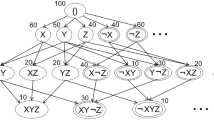Abstract
The use of objects and rules in modern database systems is the main focus of the IDEA Esprit Project. In particular, it inspires the IDEA Methodology, a comprehensive and systematic approach to the design of database applications which use both deductive and active rules. The IDEA Methodology reconciles deductive and active rules by assigning them the role of expressing knowledge about the application domain, either with a purely declarative style, or with a more procedural style. Although active rules are inherently procedural, in many cases they can be automatically or semi-automatically generated from declarative specifications.
This paper is focused on active rules, the main research interest of the Politecnico in the IDEA project. We concentrate on active rule analysis, design, and prototyping as developed in the context of the IDEA Methodology. Given that active rules are quite complex to understand and manage, we present several abstractions and techniques which enable their safe specification, in particular with respect to collective desired properties (such as termination). We also informally introduce the notion of modularization, that enables the partitioning of complex rule sets into modules which exhibit nice interaction properties.
Research presented in this paper is supported by Esprit project P6333 IDEA, and by ENEL contract “VDS 1/94: Integrity Constraint Management”
Preview
Unable to display preview. Download preview PDF.
Similar content being viewed by others
References
A. Aiken, J. Widom, and J. M. Hellerstein. Behavior of database production rules: Termination, confluence, and observable determinism. In M. Stonebraker, editor, Proc. ACM SIGMOD Int'l Conf. on Management of Data, pages 59–68, San Diego, California, May 1992.
E. Baralis, S. Ceri, and S. Paraboschi. Modularization techniques for active rules design. Technical Report IDEA.WP2.22P.002.01, ESPRIT Project n. 6333 IDEA, Nov. 1994. Submitted for publication.
E. Baralis, S. Ceri, and S. Paraboschi. ARACHNE: A tool for the analysis of active rules. Technical Report IDEA.WP2.22P.005.01, ESPRIT Project n. 6333 IDEA, June 1995.
E. Baralis, S. Ceri, and S. Paraboschi. Improved rule analysis by means of triggering and activation graphs. In T. Sellis, editor, Proc. of the Second Workshop on Rules in Databases Systems, LNCS, Athens, Greece, Sept. 1995. To appear.
E. Baralis and J. Widom. An algebraic approach to rule analysis in expert database systems. In Proc. Twentieth Int'l Conf. on Very Large Data Bases, pages 475–486, Santiago, Chile, Sept. 1994.
G. Booch. Object Oriented Analysis and Design with Application, Second Edition. Benjamin Cummings, 1994.
F. Bry, H. Decker, and R. Manthey. A uniform approach to constraint satisfaction and constraint satisfiability in deductive databases. In Proc. First Int'l Conf. on Extending Database Technology, LNCS n.303, pages 487–505, Venice, Italy, 1988.
S. Ceri. A declarative approach to active databases. In Proc. Eighth Int'l Conf. on Data Engineering, pages 452–456, Tempe, Arizona, Apr. 1992.
S. Ceri and P. Fraternali. The IDEA Methodology. Technical Report IDEA.WP2.22P.001.03, ESPRIT Project n. 6333 IDEA, June 1995.
S. Ceri, P. Fraternali, S. Paraboschi, and L. Tanca. Automatic generation of production rules for integrity maintenance. ACM Transactions on Database Systems, 19(3):367–422, Sept. 1994.
S. Ceri, P. Fraternali, S. Paraboschi, and L. Tanca. Active rule management in Chimera. In J. Widom and S. Ceri, editors, Active Database Systems. Morgan-Kaufmann, San Mateo, California, 1995.
S. Ceri and R. Manthey. Consolidated specification of Chimera, the conceptual interface of Idea. Technical Report IDEA.DD.2P.004, ESPRIT Project n. 6333 Idea, June 1993.
S. Ceri and J. Widom. Deriving production rules for constraint maintenance. In D. McLeod, R. Sacks-Davis, and H. Schek, editors, Proc. Sixteenth Int'l Conf. on Very Large Data Bases, pages 566–577, Brisbane, Australia, Aug. 1990.
S. Ceri and J. Widom. Deriving incremental production rules for deductive data. Information Systems, 19(6):467–490, Nov. 1994.
P. P. Chen. The entity-relationship model: toward a unified view of data. ACM Transactions on Database Systems, 1(1):9–36, 1976.
P. Coad and E. Yourdon. Object Oriented Analysis. Prentice-Hall International, 1990.
D. Coleman, P. Arnold, S. Bodoff, C. Dollin, H. Gilchrist, F. Hayes, and P. Jeremaes. Object Oriented Development: The Fusion Method. Prentice-Hall International, Englewood Cliffs, New Jersey, 1994.
C. Collet, T. Coupaye, and T. Svensen. Naos, efficient and modular reactive capabilities in an object-oriented database system. In Proc. Twentieth Int'l Conf. on Very Large Data Bases, pages 132–143, Santiago, Chile, Sept. 1994.
S. Cook and J. Daniels. Designing Object Systems. Prentice-Hall International, 1994.
N. Gehani and H. V. Jagadish. ODE as an active database: Constraints and triggers. In G. M. Lohman, A. Sernadas, and R. Camps, editors, Proc. Seventeenth Int'l Conf. on Very Large Data Bases, pages 327–336, Barcelona, Spain, Sept. 1991.
D. Harel. Statecharts: a visual formalism for complex systems. Science of Computer Programming, 8:231–274, 1987.
Illustra user's guide, server release 2.1, June 1994.
R. Manthey and F. Bry. Satchmo: a theorem prover implemented in prolog. In Proc. 9th Intern. Conf. on Automated Deduction CADE'88, number 310 in Lecture Notes in Computer Science, pages 1006–1023, Argonne, Illinois, May 1988. Springer-Verlag, Berlin.
Oracle 7 server concepts manual, Dec. 1992. Number 6693-70.
J. Rumbaugh, M. Blaha, W. Premerlani, F. Eddy, and W. Lorensen. Object-Oriented Modeling and Design. Prentice Hall, 1991.
T. Validity Team, Bull NH Information Systems. Del language reference manual, v1.2, Apr. 1995.
J. Widom and S. Ceri. Active Database Systems. Morgan-Kaufmann, San Mateo, California, Aug. 1995.
Author information
Authors and Affiliations
Editor information
Rights and permissions
Copyright information
© 1995 Springer-Verlag Berlin Heidelberg
About this paper
Cite this paper
Ceri, S., Baralis, E., Fraternali, P., Paraboschi, S. (1995). Design of active rule applications: Issues and approaches. In: Ling, T.W., Mendelzon, A.O., Vieille, L. (eds) Deductive and Object-Oriented Databases. DOOD 1995. Lecture Notes in Computer Science, vol 1013. Springer, Berlin, Heidelberg. https://doi.org/10.1007/3-540-60608-4_31
Download citation
DOI: https://doi.org/10.1007/3-540-60608-4_31
Published:
Publisher Name: Springer, Berlin, Heidelberg
Print ISBN: 978-3-540-60608-6
Online ISBN: 978-3-540-48460-8
eBook Packages: Springer Book Archive




